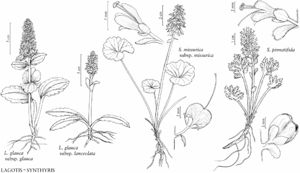Difference between revisions of "Lagotis glauca subsp. glauca"
FNA>Volume Importer |
imported>Volume Importer |
||
| (3 intermediate revisions by 2 users not shown) | |||
| Line 1: | Line 1: | ||
{{Treatment/ID | {{Treatment/ID | ||
|accepted_name=Lagotis glauca subsp. glauca | |accepted_name=Lagotis glauca subsp. glauca | ||
| − | |accepted_authority= | + | |accepted_authority= |
|publications= | |publications= | ||
|special_status={{Treatment/ID/Special_status | |special_status={{Treatment/ID/Special_status | ||
|code=F | |code=F | ||
| − | |label= | + | |label=Illustrated |
}} | }} | ||
|basionyms= | |basionyms= | ||
| Line 23: | Line 23: | ||
|elevation=0–1100 m. | |elevation=0–1100 m. | ||
|distribution=Alaska;e Asia (Russian Far East). | |distribution=Alaska;e Asia (Russian Far East). | ||
| − | |discussion=<p>Subspecies glauca occurs along the coast of the Alaska Peninsula, Aleutian Islands, Kodiak Island, the Pribilov Islands, and, intermittently, to Teller on the Seward Peninsula. Transitional basal leaf forms occur where < | + | |discussion=<p>Subspecies glauca occurs along the coast of the Alaska Peninsula, Aleutian Islands, Kodiak Island, the Pribilov Islands, and, intermittently, to Teller on the Seward Peninsula. Transitional basal leaf forms occur where <i></i>subsp.<i> glauca</i> is sympatric with <i></i>subsp.<i> lanceolata</i>; <i></i>subsp.<i> glauca</i> is then distinguished in most cases by having shorter stamen filaments. Some specimens are difficult to place in either subspecies in this zone of contact.</p> |
|tables= | |tables= | ||
|references= | |references= | ||
| Line 32: | Line 32: | ||
-->{{#Taxon: | -->{{#Taxon: | ||
name=Lagotis glauca subsp. glauca | name=Lagotis glauca subsp. glauca | ||
| − | + | |authority= | |
| − | |authority= | ||
|rank=subspecies | |rank=subspecies | ||
|parent rank=species | |parent rank=species | ||
| Line 46: | Line 45: | ||
|publication title= | |publication title= | ||
|publication year= | |publication year= | ||
| − | |special status= | + | |special status=Illustrated |
| − | |source xml=https:// | + | |source xml=https://bitbucket.org/aafc-mbb/fna-data-curation/src/2e0870ddd59836b60bcf96646a41e87ea5a5943a/coarse_grained_fna_xml/V17/V17_715.xml |
|genus=Lagotis | |genus=Lagotis | ||
|species=Lagotis glauca | |species=Lagotis glauca | ||
Latest revision as of 19:36, 5 November 2020
Basal leaves 6–16 cm; blade broadly obovate-oblanceolate, 35–80 × 20–65 mm, base truncate, margins crenate-dentate, apex rounded or obtuse, sometimes subacute. Cauline leaves: blade ovate to triangular, margins crenate-dentate. Flowers: filaments to 1.5 mm, often shorter than to as long as anthers. 2n = 22.
Phenology: Flowering summer.
Habitat: Coastal tundra meadows.
Elevation: 0–1100 m.
Distribution
Alaska, e Asia (Russian Far East).
Discussion
Subspecies glauca occurs along the coast of the Alaska Peninsula, Aleutian Islands, Kodiak Island, the Pribilov Islands, and, intermittently, to Teller on the Seward Peninsula. Transitional basal leaf forms occur where subsp. glauca is sympatric with subsp. lanceolata; subsp. glauca is then distinguished in most cases by having shorter stamen filaments. Some specimens are difficult to place in either subspecies in this zone of contact.
Selected References
None.
